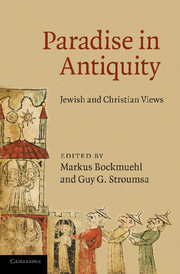Book contents
- Frontmatter
- Contents
- Notes on contributors
- 1 Introduction: the paradise chronotrope
- PART I PARADISES OF SECOND TEMPLE JUDAISM AND CHRISTIAN ORIGINS
- 2 The messiah in the garden: John 19.38–41, (royal) gardens, and messianic concepts
- 3 Philo's scholarly inquiries into the story of paradise
- 4 Paradise in the Biblical Antiquities of Pseudo-Philo
- 5 Paradise, gardens, and the afterlife in the first century ce
- 6 Paradise in the New Testament
- 7 Quis et unde? Heavenly obstacles in Gos. Thom. 50 and related literature
- PART II CONTEMPORIZING PARADISE IN LATE ANTIQUITY
- 15 Epilogue: a heaven on earth
- Select bibliography
- Index of subjects
- Index of authors (cited in text)
- Index of sources
7 - Quis et unde? Heavenly obstacles in Gos. Thom. 50 and related literature
Published online by Cambridge University Press: 06 December 2010
- Frontmatter
- Contents
- Notes on contributors
- 1 Introduction: the paradise chronotrope
- PART I PARADISES OF SECOND TEMPLE JUDAISM AND CHRISTIAN ORIGINS
- 2 The messiah in the garden: John 19.38–41, (royal) gardens, and messianic concepts
- 3 Philo's scholarly inquiries into the story of paradise
- 4 Paradise in the Biblical Antiquities of Pseudo-Philo
- 5 Paradise, gardens, and the afterlife in the first century ce
- 6 Paradise in the New Testament
- 7 Quis et unde? Heavenly obstacles in Gos. Thom. 50 and related literature
- PART II CONTEMPORIZING PARADISE IN LATE ANTIQUITY
- 15 Epilogue: a heaven on earth
- Select bibliography
- Index of subjects
- Index of authors (cited in text)
- Index of sources
Summary
INTRODUCTION
Ever since Adam and Eve were expelled from paradise, people have been trying to get back in again. The protoplasts' return, however, was blocked by cherubim and a flaming sword (Gen. 3.24), and post-biblical tradition has elaborated further on these obstacles, while also developing ways to get around or through them. Some have thought this possible even during earthly life: witness Paul's rapture ἓως τρíτου οὐρανοῦ … εἰς τὸν παράδεισον (2 Cor. 12.3, 4), or the four who entered the Pardes (however that is to be understood) in rabbinic tradition (b. Hag. 14b). Others, however, have thought in terms of a post-mortem journey, like Jesus and the penitent thief (Luke 23.43).
The focus of this chapter is the character of journeys through the heavenly realms, whether in this life or the next, in early Christian and Christian-influenced literature up to about 300 ad. Specifically, we will examine works which refer to methods for passing guardian figures blocking heavenly ascent. The motif is identified by Rudolph as a favorite gnostisches theme:
Jedenfalls haben viele der gnostischen Schriften das Thema der Seelenreise als Himmelfahrt durch die feindliche Welt der Gestirne, Planeten oder „Archonten“ (ursprünglich ein Name für „Beamte“) zum Inhalt. Allein von den 46 neuen gnostischen Texten aus Nag Hammadi, die seit 1945 bekannt geworden sind, befassen sich 12 damit.
The focus in this essay will be on narratives of passage past these obstacles, or on detailed prescriptions of how to pass them, rather than on brief allusions to this motif, which are also common.
- Type
- Chapter
- Information
- Paradise in AntiquityJewish and Christian Views, pp. 82 - 100Publisher: Cambridge University PressPrint publication year: 2010
- 3
- Cited by



